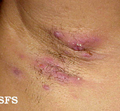Hidradenitis suppurativa
| Hidradenitis suppurativa | |
|---|---|

| |
| Synonyms | Acne inversa, acne conglobata, apocrine acne, Verneuil's disease, Velpeau’s disease |
| Pronounce | N/A |
| Field | Dermatology |
| Symptoms | Multiple inflamed and swollen skin lesions |
| Complications | |
| Onset | Young adulthood |
| Duration | Long-term |
| Types | Stage I, II, III |
| Causes | Unknown |
| Risks | |
| Diagnosis | Based on symptoms |
| Differential diagnosis | Acne, acne conglobata, pilonidal cysts |
| Prevention | |
| Treatment | Warm baths, laser therapy, surgery |
| Medication | Antibiotics, immunosuppressive medication |
| Prognosis | |
| Frequency | 1–4% of people |
| Deaths | Rare |
Hidradenitis suppurativa (HS), alternatively known as acne inversa, is a chronic skin disease manifested by recurrent inflamed lesions and nodules. These lesions are frequently painful and prone to rupture, releasing fluid or pus. Scar tissue often forms after the lesions heal. Due to its physical manifestations, HS can have significant psychosocial impacts, including self-consciousness and depression.
Presentation and Affected Areas[edit]
HS typically manifests in areas of the body where skin rubs together, like the axillary (underarm) regions, inframammary (under the breasts) areas, and the groin. Lesions may also develop around the anal and genital areas. The skin condition evolves from small, pimple-like bumps to hard, painful nodules that can persist for weeks or months.
Etiology[edit]
The precise etiology of HS remains uncertain, but it's thought to arise from a combination of genetic predispositions and environmental triggers. Approximately one-third of HS patients have a family history of the disease. Modifiable risk factors, such as obesity and smoking, are also associated with HS. The condition is not infectious, and it does not result from poor hygiene or deodorant use.
The pathogenesis is believed to involve either apocrine sweat gland dysfunction or hair follicle abnormalities, leading to follicular occlusion and secondary bacterial infection and inflammation.
Diagnosis[edit]
Diagnosis of HS is primarily clinical, based on characteristic patient history and physical examination. The recurrent nature of the painful, pus-filled nodules in the characteristic body areas strongly points to this condition.
Treatment[edit]
Management of HS focuses on reducing flare-ups, relieving symptoms, and preventing disease progression. It often involves a combination of lifestyle modifications, medications, and in severe cases, surgical intervention.
References[edit]
<references group="" responsive="1"></references>
See also[edit]
|
|
|
-
Hidradenitis suppurativa
-
Hidradenitis suppurativa growths
-
Hidradenitis suppurativa on abdomen
-
Hidradenitis suppurativa
-
Micrograph of hidradenitis suppurativa
-
Hidradenitis suppurativa lesions
-
Hidradenitis suppurativa on leg
Ad. Transform your life with W8MD's Budget GLP-1 injections from $75


W8MD offers a medical weight loss program to lose weight in Philadelphia. Our physician-supervised medical weight loss provides:
- Weight loss injections in NYC (generic and brand names):
- Zepbound / Mounjaro, Wegovy / Ozempic, Saxenda
- Most insurances accepted or discounted self-pay rates. We will obtain insurance prior authorizations if needed.
- Generic GLP1 weight loss injections from $75 for the starting dose.
- Also offer prescription weight loss medications including Phentermine, Qsymia, Diethylpropion, Contrave etc.
NYC weight loss doctor appointmentsNYC weight loss doctor appointments
Start your NYC weight loss journey today at our NYC medical weight loss and Philadelphia medical weight loss clinics.
- Call 718-946-5500 to lose weight in NYC or for medical weight loss in Philadelphia 215-676-2334.
- Tags:NYC medical weight loss, Philadelphia lose weight Zepbound NYC, Budget GLP1 weight loss injections, Wegovy Philadelphia, Wegovy NYC, Philadelphia medical weight loss, Brookly weight loss and Wegovy NYC
|
WikiMD's Wellness Encyclopedia |
| Let Food Be Thy Medicine Medicine Thy Food - Hippocrates |
Medical Disclaimer: WikiMD is not a substitute for professional medical advice. The information on WikiMD is provided as an information resource only, may be incorrect, outdated or misleading, and is not to be used or relied on for any diagnostic or treatment purposes. Please consult your health care provider before making any healthcare decisions or for guidance about a specific medical condition. WikiMD expressly disclaims responsibility, and shall have no liability, for any damages, loss, injury, or liability whatsoever suffered as a result of your reliance on the information contained in this site. By visiting this site you agree to the foregoing terms and conditions, which may from time to time be changed or supplemented by WikiMD. If you do not agree to the foregoing terms and conditions, you should not enter or use this site. See full disclaimer.
Credits:Most images are courtesy of Wikimedia commons, and templates, categories Wikipedia, licensed under CC BY SA or similar.
Translate this page: - East Asian
中文,
日本,
한국어,
South Asian
हिन्दी,
தமிழ்,
తెలుగు,
Urdu,
ಕನ್ನಡ,
Southeast Asian
Indonesian,
Vietnamese,
Thai,
မြန်မာဘာသာ,
বাংলা
European
español,
Deutsch,
français,
Greek,
português do Brasil,
polski,
română,
русский,
Nederlands,
norsk,
svenska,
suomi,
Italian
Middle Eastern & African
عربى,
Turkish,
Persian,
Hebrew,
Afrikaans,
isiZulu,
Kiswahili,
Other
Bulgarian,
Hungarian,
Czech,
Swedish,
മലയാളം,
मराठी,
ਪੰਜਾਬੀ,
ગુજરાતી,
Portuguese,
Ukrainian









